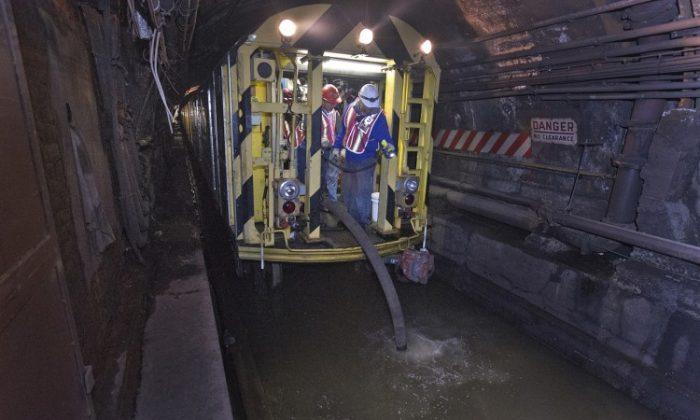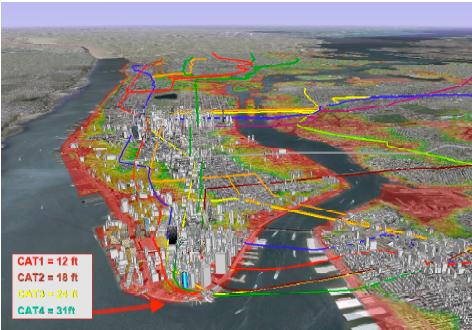NEW YORK—The New York City subway system—built in large part in the early 1900s—has aged considerably over the years. Money for keeping up maintenance has been hard to find, not to mention protecting the valuable asset against any potential future storms.
“It is like an overcoat handed down through four generations and worn every day, yet never much more than patched when an elbow shows through,” said Projjal Dutta, the first director of sustainability for the MTA, in a Huffington Post op-ed.
“A system which went into service when the current riders’ grandparents were yet unborn, it needs a larger infusion of resources than transit in New York has ever had,” continued Dutta. “The scale of infusion requires political championing and popular consensus-building much beyond what an operating agency can muster.”
Interviews with experts and those directly involved with transit in New York City, and a review of about a dozen documents pertaining to sea level rise and flooding, show that the future of transit protection is as murky as the unprecedented amounts of corrosive saltwater that lingered in subway tunnels for days and weeks, disrupting millions of New Yorkers.
Flooding and Extreme Weather, Previously
The jarring impact of Superstorm Sandy was unforeseen, but not unforetold.
Flooding, especially, has over the years forced the MTA to evaluate its entire system. An unexpected storm in August 2007 dumped from 1.4 inches to 3.5 inches of rain in two hours across New York City, overwhelming pumps. That storm was preceded by two others in 2007—in April, 7 inches of rain fell, breaking a 1882 record—and one in 2004.
The latter prompted a review by the MTA’s inspector general and its board, and later a change to water and waste management, including the beginning of raising subway grates, which is thought to have prevented some damage from Sandy.
Additionally, a score of reports about the potential effects of a changing climate were published in 2006 and the next four years. Some were read and used by the MTA, which brought some report authors and experts, such as Klaus Jacobs of the Columbia Center for Climate Systems Research, in as advisers.
Dangers included shifting temperatures and heavier rainfall, but perhaps of most concern was the prediction—from at least as far back as 1997—that a sea level rise could begin turning what are called once in 100-year storms into once in 10-year storms, at least before the end of this century.
But these reports, written before hurricane turned Tropical Storm Irene, and years before Superstorm Sandy, were not yet connected to what drives reports home—a manifestation of what they outline.
A principal cause of destruction this time was saltwater . . . read more
Flooding During Sandy
“New York City’s transit system flooded as never witnessed before,” said Rick Grant of Russell Corrosion Consultants, which assesses the condition of transit and other systems.
The subway system, along with other infrastructure such as natural gas lines, power stations, and water supply systems, haven’t, for the most part, been around for damage like Sandy wrought. Most were not built with such extreme weather patterns in mind.
A principal cause of destruction in the subway system was that, unlike the 2004 and 2007 storms, saltwater flooded the system.
“Anything metallic, any metallic structure is going to corrode,” said Grant. “Now that you throw the storm effects into it, and the extremely corrosive rates of saltwater, you’ve got a very big problem on your hands.”
The life span of some of the thousands of miles of track will be shortened because of the corrosion, and the flooding “is going to wreak some havoc with the electrical components, for sure,” Grant added.
The impact of Sandy may have stopped being felt by many New Yorkers by now. But much like those still without power three weeks later, some subway riders are still enduring closures. Portions of the R and No. 1 lines are still closed from storm damage.
Others took more than a week of draining and rehabilitation after the storm, such as the L line. Also, an important link from Southeast Queens to the Rockaway Peninsula, the Broad Channel bridge, was knocked out. Repairs are estimated to take months.
An MTA representative confirmed Sunday that the agency, whether discussing specifics internally at this point or not, continues working on getting the entire system up and running before publicly endorsing solutions to vulnerable areas exposed during the storm.
Meanwhile, Joseph Lhota, chairman and CEO of the authority, said after a recent public meeting that he couldn’t talk specifics because hardening infrastructure would have to be a collaboration between multiple parties, including different levels of government, community boards, and real estate owners.
“If you just did certain things for the subways and didn’t treat anything else, it’s not going to be as effective as if we all work together,” he said. “It needs to be comprehensive because of how broad-based the surge is.”
The agency has already progressed over the last five years in planning for disaster and identifying weak spots, said Steve Winkelman, director of transportation and adaptation programs at the Center for Clean Air Policy. He, like many others, lauded the agency’s preparation, such as how they moved trains to higher elevations and shut down the system before the storm.
Planning for Storm Protection, and Finding Funding
The raised grates helped, but they were mostly planned for heavy rainfall. Other measures have also improved the system, and the agency’s communication and procedures—such as figuring out when to shut down the system so people aren’t left stranded—have greatly improved from even the 2010 blizzard.
But new levels of storm protection are needed. Yet no one knows what, exactly, can be put on the table then put into place quick enough to protect against the next storm—if there is one—that could come in one year or 10.
“The key question is, how do we integrate it into capital and operating budgets? Because you can’t protect everything all at once,” said Winkelman.
Gov. Andrew Cuomo formed three commissions to research storm preparedness late last week, including one that will in part examine transportation systems. He said earlier this month he’s seeking $3.5 billion to repair bridges, tunnels, and transit.
Already dealing with money problems, the MTA has outstanding debt of almost $32 billion, according to an August report from Moody’s. The agency spends more than $2 billion a year on debt service. It is planning on increasing fares in March 2013 and March 2015 because, in part, of its increasing debt.
The current capital budget, a four-year budget separate from the operating budget that is used for expanding and maintaining the sprawling and aging system, will end in 2015. The next capital budget doesn’t have funding in place but is being developed, and will likely include storm protection work, according to an MTA spokesperson.
One possible protection improvement would be developing gates that can be shut at station entrances, which they use in London. Multiple stations were severely damaged by flooding from Sandy, most notably the South Ferry station in Lower Manhattan, which was rehabbed through 2009 at a cost of more than $500 million.
Lhota, said he expects to be reimbursed almost entirely by FEMA for any damage from the storm. But emergency funding, which almost always comes in much higher after the fact, should be dedicated before more disasters hit, according to John-Michael Cross, policy associate for transportation in communities with the Environmental and Energy Study Institute, which advocates to Congress for innovative policy solutions.
“We’re spending billions of dollars on emergency funds every year to the point where they’re predictable but we still have no budget for it,” he said. “But invariably it’s not enough, and [then] it needs to come out of local systems’ operating budgets.”
Cross also suggests raising the federal gas tax, which gleans 18.4 cents a gallon, since it hasn’t been raised for 20 years and has lost purchasing power due to inflation.
The problem, he says, is top management of systems, including the MTA, are expecting more storms and want to invest in strengthening the infrastructure, but are not able to get political support.
“We need to think about spending more in the short term to protect long-term assets, to build things that are going to be around for 80–100 years, because that will save money in the long run,” he said.
The Epoch Times publishes in 35 countries and in 19 languages. Subscribe to our e-newsletter.
Please send news tips to [email protected]



















